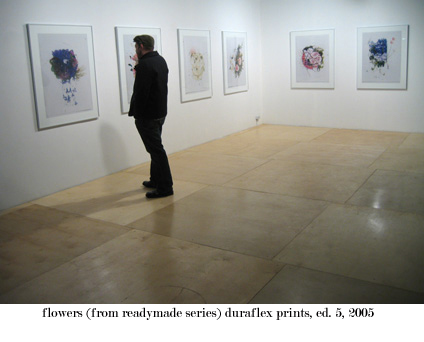 |
art writing notes back to blog / back to website |
| Toronto art reviews online: Artfag / BlogT.O. (arts) / Broken Pencil / Canadian Art / Gary Michael Dault / Eye Magazine / Flack / Peter Goddard / Sarah Milroy / Philip Monk / Ron Nurwisah / Simpleposie / Torontoist / Samplesize / RM Vaughan / more? send me the link |
Notes on artwriting by Sally Mckay are available here
Please read RM Vaughan's very useful poem 7 Steps To a Better Artist Statement.
Students from the Professional Practice course taught by Cathy Daley and Sarah Nind at Ontario College of Art and Design, are invited to submit reviews of Toronto art shows for posting on this page.

Paul Butler, Getting There is Half the Fun
reviewed by Valeria Rzianina
I strolled into the Wynick/Tuck Gallery at 401 Richmond Street West and was immediately drawn to Paul Butler’s pretty little collages from the Readymade Series. Approximately every couple of months, Butler hosts these collage parties across Canada and internationally, where artists come together to create art. He then proceeds to gather the remnants left behind by the other artists and uses them as “readymades” for his own designs. The show, appropriately named Getting There is Half the Fun, explores the artist’s relationship to the art-making process and runs from January 14 to February 1, 2006.
Paul Butler’s new series, as influenced by Marcel Duchamp’s concept of “the readymade – finding art in the everyday,” is a collection of accumulated work from his renowned collage parties. The collages, which vary in size and consist of bold patterns, multiple layers of colour and cutouts of different images, are all put together in neat, white frames to create simple yet stunning works of art. Getting There is Half the Fun promotes, what seems like, two separate collections. One side of the gallery displays collages made from fashion magazines which, unmistakably, speak about popular culture. The other side of the gallery, however, presents images of flowers and plants that were intricately pieced together in the shape of bouquets, photographed and developed as 40”x30” Duraflex prints. I really like the simplicity of Butler’s work, even though some of the images he creates hint at more complex issues such as advertising and its superficial outlook on life and beauty. My favourite piece is Random, a collage which shows a fashion model with her body cutout and layered over a bright green and white background with the word “random” as the only evidence of the original advertisement. To me, Random, speaks about how disposable fashion models are. They are a dime a dozen and can easily be replaced by the next girl to model next season’s designer fashions. Of course, this is solely my opinion and I am sure each individual viewer will look at Random with their own set of interpretations.
Paul Butler’s Getting There is Half the Fun is a show not to be missed. The simplistic approach that Butler applies to his practice ensures that any viewer can enjoy his collages. But if you crave a deeper meaning, stop and think about the world around you for a minute and the Readymade Series will suddenly seem increasingly complex.

Review by Valeria Rzianina as part of an artwriting project for OCAD's Professional Practice course taught by Cathy Daley and Sarah Nind.
Notes by Sally Mckay for guest lecture with Ann MacDonald for the Professional Practice course taught by Cathy Daley and Sarah Nind at Ontario College of Art and Design, January 17th, 2006.
Fundamental:
People are smart. Art is for everyone. Writing in an informal style does not equate with lazy thinking.Three more things to keep in mind:
The time when you are most afraid of looking stupid is usually the time when you are about to say something that other people are dying to hear.
For optimum fun and maximum impact, your work should sometimes be scary enough to get your heart rate up.
Address your art writing to the readers, not to the artists.
Basic types of art writing:
Reviews tend to be descriptive and informational, and they impart a sense of the show for people who haven't seen it.
Examples: RM Vaughan, Catherine Osborne, Broken Pencil, Lola ShotgunsCriticism locates the artwork as part of a larger cultural discussion.
Examples: Peggy Gale, Dot Tuer: (1 / 2), Julian Stallabrass, Tom Moody, Jennifer McMackonTheory often presents the writing itself is a new thing in the world for the reader's consideration, a proposed set of parameters for the mind to roam, much like an artwork. I would include ficto-criticism in this category.
Examples: Jeanne Randolph: (1 / 2), Philip Monk, Critical Art EnsembleMost artwriting combines elements of all three of the above forms:The best reviews do a good job of describing the work.These two elements are pretty straightforward. The first relies on observation and turn of phrase, the second can be achieved by doing your research. The third part is more tricky, but very sexy, and this is usually where the motivation lies.
The best reviews usually also go at least some way towards locating the work within a larger context.Good reviews usually also include something of the writer's particular point of view. Sometimes this is a personal connection to the work, and somtime it is an emotional reaction. Sometimes the writer is speaking from a theoretical position. The spectrum is wide and various and fraught with pitfalls:The simplest approach is to draw a personal connection to the work. This is hard to screw up. Artists, art writers, art audiences, and art review readers all share the same world. If you are able to relate the work to your own personal experience, chances are at least some of your readers will be able to relate. The danger is in making a review that's all about you, instead of about the art, but some people really go for that, so the worst case scenario isn't all that bad.Addenda:
The second dumbest thing you can do is fake an emotional reaction. It's pretty easy to do, and it won't make you look quite as idiotic as faking a theory, but it will make your readers (and likely yourself) depressed and apathetic and add to the already overbrimming cultural pot of pointlessness. Articulating emotion is tough. It's easy to screw up and look like you are faking it, when you actually really feel everything you are saying. One trick is to make yourself aware of clichés and avoid them as much as possible. If you are delving into cliché territory just remember that there's no law against clichés, but if you are going to use one you'd better have a good reason.
The very most dumbest thing a writer can do is fake a theory. This leads to lots of mis-use of big words and sad, lame, embarrassing texts. It's fairly common in schools, where people are intimidated by academic writing and just start cramming in jargon they don't understand in order to get good marks. But genuine good theory (original thought!) is one of the most joyful inspiring things that Western Culture has to offer. Good theory can provide new, branching trajectories of thought and exploration for whole groups of people. This is why art jargon was invented. Like in science, or any technical field, specialised vocabularies form so people who are studying the stuff can communicate efficiently and move forward with their projects. When it comes time to describe these projects to the larger community, those with specialised knowledge need to make the extra intellectual investment required to let go of the technical terms and describe their concepts so lay people can get it. Luckily people tend to be really smart, and while words we don't know might slow us down, complicated concepts are no problem at all.
Note: one snag in all this is that the current cultural move away from heirarchical power structures also involves an implication that technical language is elitist and intentionally exclusive. The class and economic factors around this discussion are super interesting and complex, and I can't get into it here. I do think that art markets rely on trumped-up notions of the magical specialness of art. Anti-intellectualism, however, is a bad scary thing that shuts down questioning and leads to Intelligent Design-style investment in belief systems. It's a good idea to keep in mind that just because someone is using big words, that doesn't mean they are bullshitting. Instead, we might give them the benefit of the doubt and assume that they are using those words in order to make a very specific, carfully considered point. And we can always go look it up on Google dictionary if we get stumped.
An ability to write about art is extremely useful to all professional art pursuits. Other important types of artwriting that are worthy of further study include artist's statements, press releases, and grant applications. Most experienced artist/writers will agree that writing your own artist statement is the very most painful project of all. If you are stuck, or need advice, please read RM Vaughan's very useful poem 7 Steps To a Better Artist Statement.
It is difficult to make a living as an art writer. As with many apspects of the arts, an art writing career often requires supplemental income from other sources, and it pays to culitvate a variety of marketable skills. Newspaper and magazine editors crave copy that is human, engaging and emotionally direct, but they are often fickle or otherwise restricted in terms of what they can accept for publication. There aren't a lot of openings for art writers in popular media, where the money is.
Getting your artwriting published can be very easy. Some publishers, like Broken Pencil, accept unsolicited reviews and print a lot of them. Others, such as Canadian Art magazine, are always looking for new writers with fresh perspectives. Art magazines in Canada and around the world are often interested in new voices. And then of course there's always blogging...
comments welcome...